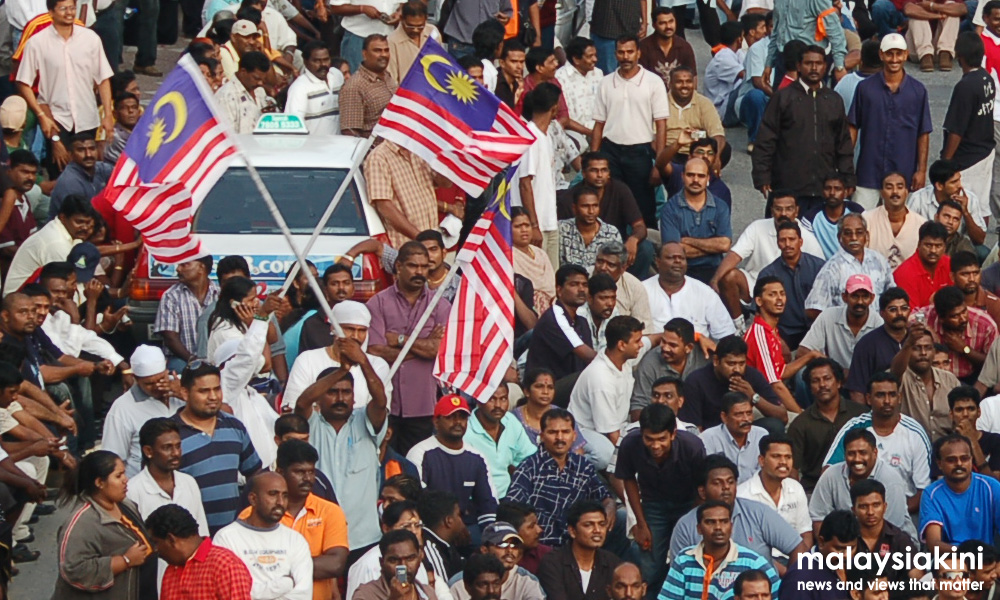
The Malaysian Indian Blueprint (MIB) recently launched by the Prime Minister Najib Abdul Razak is another more serious attempt to help the Indian community.
Although many have dismissed it as an election ploy for GE14, I feel that the objectives are attainable if a substantial and meaningful effort is made this time around.
As the MIC, which celebrated its 70th anniversary last year, has a long record of failures – and some successes like the formation of the AIMST University ,the MIED (Maju Institute Of Educational Development) and Tafe college – the federal government has to take the main lead and responsibility to bring the plan to fruition.
Helping the bottom 40 percent income earnears (B40) should be the priority and an effort should be made to reach out and register the number of B40s in every parliamentary constituency, no matter how much of hard work and trouble it entails, to ensure that they get the promised assistance as well as record their progress.
The B40 is in real dire shape and are not only poor but also prone to various social ills and infused with negative values. It is not easy to uplift this group but an effort needs to be made somehow for their long-term progress.
The Indian community’s present poor standing can be traced back to the formation of the MIC in 1946 by Dr John Thivy and other well-intentioned leaders of the community.
When the MIC was formed it was led by a group of English-educated Indians and they were mostly keen on serving the community.
This group had the mission and vision for Indians when they formed the MIC and more importantly being erudite they could lead and hold their own ground against the stronger presence of the Malays and the Chinese and their political parties.
The change after Merdeka when the Tamil-educated groups took over the MIC was a downward spiral if not a nose dive for the Indians.
This group had no vision for the community other than its day to day survival in a country that was experiencing rapid change, and this group was meek and weak enough to be subdued to play a subordinate role.
Unlike the English-educated leaders, the Tamil-educated groups had no foresight or insight about how to lead the community to greater heights. It was a case of the blind leading the blind.
Even though the English-educated leadership was elitist, they had the best interests of Indians in mind unlike the Tamil-educated groups who were mostly not well off and became self-serving and feeding off the allocations and assistance schemes provided by the government to help needy Indians.
This tendency and attitude of the MIC leaders at all levels prevails and affects the community to this day.
Former MIC president S Samy Velu tried to lure back the English-educated group and the professionals but it was too late and had limited success only.
It is undeniable that the leaders in the professions,corporate and government sectors were the English-educated. These Indians mainly comprise of urban Tamils, Sikhs, Malayalees and Jaffna Tamils were a class above the rest.
These people had the capability and more importantly the vision to help the poor Indians mainly Tamils who were split by caste, factions and other trivial divisions.
The English-educated Indians never minded about caste or ethnicity unlike the Tamil-educated ones who thrived on the caste, language and other divisions in the community.
The Tamil-educated groups had a limited agenda comprising of Tamil schools,temples and Tamil language and not the big picture comprising of political power and socio-economic advancement.
The former are important no doubt but socio-economic progress is paramount for the community as it will take care of the other needs.
Both the MIC and the National Union of Plantation Workers were resistant to change and were satisfied to ensure that the status quo prevailed in the estates , from where they drew their main membership.
When change did come knocking on their doors in the estates beginning from the 1980s the Indians were totally unprepared and subsequently landed in the pitiable condition they are facing now.
Even the issue of citizenship, which was much easier to apply and receive during the 1960s, was not given sufficient importance by the MIC leaders and the citizenship problem prevails to this day.
I am sure that the fate of Indians could have been very much different had the English-educated Indians led the MIC after Independence when a lot of socio-economic plans were formulated and implemented and this group could have strongly pressured the government and firmly ensured that Indians were not marginalized despite being a minority.
What happened after Merdeka was a slow regressing of the Indian community,which was accelerated during Prime Minister Dr Mahathir Mohamad’s long tenure and we can see where the Indians are in 2017.
Indians are a capable, industrious and intelligent people but most of their efforts and resources have been frittered away due to poor leadership and lack of vision.
A strong political party blessed with good and visionary leaders helps a community to progress and it is the other way round if it becomes a party of self seekers.
The MIC has through the MIB a final chance to redeem and save itself from becoming history after the debacle of the last decade when the Hindraf rally and subsequent political tsunami almost finished off the party.- Mkini


No comments:
Post a Comment
Note: Only a member of this blog may post a comment.